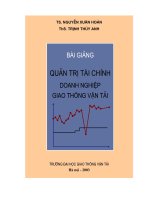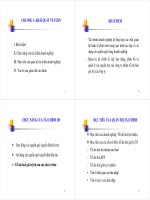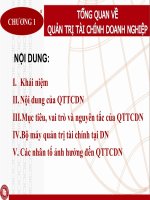bài giảng quản trị tài chính doanh nghiệp chương 4 - pgs.ts. nguyễn thu thủy
Bạn đang xem bản rút gọn của tài liệu. Xem và tải ngay bản đầy đủ của tài liệu tại đây (899.7 KB, 27 trang )
QUẢN TRỊ TÀI CHÍNH
Chương 4: Lợi tức và rủi ro
– Mơ hình định giá tài sản vốn CAPM
PGS.TS. NGUYỄN THU THỦY
Khoa Quản trị Kinh doanh
ĐẠI HỌC NGOẠI THƯƠNG
NỘI DUNG NGHIÊN CỨU
1.
2.
3.
4.
5.
MBA - FTU
Mối quan hệ giữa rủi ro và lợi nhuận
Đánh giá rủi ro/lợi nhuận của một
loại chứng khoán
Đánh giá rủi ro/lợi nhuận của một
danh mục đầu tư
Mơ hình định giá tài sản vốn (CAPM)
và ứng dụng
Tính chi phí sử dụng vốn - WACC
1
Lợi tức nắm giữ cổ phiếu
(Holding Period Returns – HPR)
l
l
l
l
l
Một cổ phiếu được mua hôm nay với giá $100. Một
năm sau, giá cổ phiếu là $116.91 và được trả cổ tức
$4.50
Dollar profit = dividend + capital gain
Dollar profit = dividend + [ending price – beginning
price] = dividend + [P1 – P0]
= 4.50 + [116.91 – 100] = 4.50 + 16.91 = $21.41
Total one-year HPR = [dividend + P1 – P0] / P0
= 4.50/100 + (116.91 – 100)/100 = 0.045 + 0.1691
= 0.2141 or 21.41%
HPR consists of 4.5% dividend yield and 16.91%
capital gains yield
Giới thiệu về rủi ro và lợi tức
l Lợi tức cổ phiếu và trái phiếu: thường được thể hiện
qua mức lợi tức trung bình (mean return) & độ lệch
chuẩn (standard deviation) (= phép đo mức độ rủi ro
hay độ phân tán của các mức lợi tức riêng lẻ xung
quanh giá trị TB)
Year
S&P 500
1981
1982
1983
1984
1985
0.1471
0.1054
0.0880
0.0985
0.0772
-0.0491
0.2141
0.2251
0.0627
0.3216
Mean return
MBA - FTU
U.S. T-bills
10.324%
15.488%
2
Giới thiệu về rủi ro và lợi tức
n
l Phương sai (variance)
å (r - r )
2
i
s2 =
i =1
n -1
l Độ lệch chuẩn (Standard deviation)
n
å (r - r )
2
i
s =
i =1
n -1
Giới thiệu về rủi ro và lợi tức
l Calculate the std.deviation of S&P500
1981-1985
à σ = 14.69% (mean = 15.49%)
l T-bills: defined as riskless investment
(mean = 10.32%)
l Realized risk premium for S&P500:
15.49% - 10.32% = 5.17% per year
MBA - FTU
3
Historical record of investment classes
and returns in the U.S. during 1926-2002
Investment
Mean returns Std. deviation
Treasury bills
Long-term T-bonds
Long-term Corp. bonds
Large firm stocks
Small firm stocks
3.8%
5.8%
6.2%
12.2%
16.9%
3.2%
9.4%
8.7%
20.5%
33.2%
Inflation
3.1%
4.4%
Compared to T-bills, large firm stocks earned an average
realized risk premium = 12.2 – 3.8 = 8.4%
Phân phối chuẩn và lợi tức cổ phiếu
Đồ thị lợi tức năm của cổ phiếu các cty lớn và nhỏ ở Mỹ rất
giống một hàm phân phối chuẩn hay đường hình chng
(a normal distribution or bell curve).
MBA - FTU
4
The normal distribution & stock returns
Phân phối chuẩn và lợi tức cổ phiếu
- Với hàm phân phối chuẩn, ta có thể dự đoán
rằng:
- 68.26% lợi tức năm nằm trong khoảng giá trị lợi tức
TB +/- 1 độ lệch chuẩn
- 95.44% lợi tức năm nằm trong khoảng giá trị lợi tức
TB +/- 2 độ lệch chuẩn
- 99.74% lợi tức năm nằm trong khoảng giá trị lợi tức
TB +/- 3 độ lệch chuẩn
- 1926-2002: Lợi tức CP các cty lớn của Mỹ có
giá trị TB là 12.2% và độ lệch chuẩn 20.5%
- Ta dự đoán rằng khoảng 68% lợi tức CP năm sẽ
thuộc khoảng từ -8.3% đến +32.7%
MBA - FTU
5
Lợi tức của một chứng khoán riêng lẻ
l Expected (ex ante) return:
¡ Future possible states “s” of the economy
¡ ps: probability of state “s” occurring
¡ Rs: return on the security if state “s” occurs
K
E ( R ) = R = å p s Rs
s =1
K
l Variance
s 2 = å p s ( Rs - R ) 2
s =1
l Std. dev.
s = var iance
Hai chứng khoán
l Covariance (hiệp phương sai) between any two
securities:
K
s AB = å p s ( Rs , A - R A )( Rs , B - R B )
s =1
l Correlation coefficient (hệ số đồng tương quan)
between any two securities:
r AB = s AB /(s As B )
MBA - FTU
6
Rủi ro và lợi tức cho một danh mục
đầu tư gồm 2 chứng khoán
Outcomes
Probability ps
RA
RB
0.25
0.50
0.25
20%
10%
0%
5%
10%
15%
Boom
Normal
Bust
Let’s calculate the expected return, covariance
and correlation of the portfolio
Rủi ro và lợi tức cho một danh mục
đầu tư gồm 2 chứng khoán
Expected return:
Std. deviation:
Covariance:
RA = RB = ...
s A = ..........%
s B = .........%
s AB = .........%
Correlation coefficient:
r AB = s AB /(s As B ) = ....................................................
Security B: very unusual à highest return in downturns,
lowest returns in boom times à concept of diversification
MBA - FTU
7
Diversification – đa dạng hóa đầu tư
l Giả sử ta đầu tư $100 vào chứng khoán A và $200 vào B. Mức lợi tức
tuyệt đối (Dollar returns) trong các tình huống cụ thể như sau:
Outcome
Prob.
CF on
$100 in A
CF on
$200 in B
Total CF
% return
on $300
in A&B
Boom
Normal
Bust
0.25
0.50
0.25
$120
$110
$100
$210
$220
$230
$330
$330
$330
10%
10%
10%
- Expected return = 10%
- Variance = 0.00
- Std.dev = 0.00 (no risk)
Diversification
l Works in many cases
l Correlation between two securities:
¡
¡
¡
¡
¡
Positively correlated:
Perfectly positively correlated:
Negatively correlated:
Perfectly negatively correlated:
Uncorrelated:
0 < ρAB < 1
ρAB = 1
-1 < ρAB < 0
ρAB = -1
ρAB = 0
à In which case, will diversification not work?
MBA - FTU
8
Lợi tức và rủi ro trong các d/mục đầu tư
l Expected return of a portfolio:
N
E ( R P ) = R P = å X i Ri
i =1
l Variance of a portfolio:
N
N
2
s P = å X i2s i2 + 2å
i =1
N
åX
i
X js ij
i =1 j =1,i ¹ j
Xi = % (or weight) of the portfolio in security “i”
N = number of securities in the portfolio.
Sum of weights = 1
Trường hợp danh mục 2 chứng khóan
E ( RP ) = X A E ( R A ) + X B E ( R B )
2
2 2
2 2
s P = X As A + X Bs B + 2 X A X Bs AB
l The above example:
E ( RP ) = 0.10
2
sP =0
MBA - FTU
9
Tập hợp đầu tư hiệu quả nhờ đa dạng hóa
(Efficient sets and diversification)
Tập hợp đầu tư hiệu quả nhờ đa dạng hóa
l Khi ρ < 1, ĐLC của một d/mục đầu tư sẽ nhỏ
hơn ĐLC trung bình trọng số của các CK riêng
lẻ à do đó, đa dạng hóa có ích (giảm rủi ro)
l Tập hợp hiệu quả (Efficient sets) = các d/mục
đầu tư trong tập hợp cơ hội đầu tư có sự kết
hợp tốt nhất giữa lợi tức và rủi ro (the best
return-risk combinations)
à Các DMĐT đó, với một ĐLC cho trước, phải
có mức lợi tức kỳ vọng cao nhất so với tất cả
các DMĐT khác trong tập hợp cơ hội đầu tư
MBA - FTU
10
Efficient set for many securities
CALs = Capital Allocation Lines = infinite linear combinations of
the riskless asset and a portfolio of risky assets.
Capital market equilibrium & CAPM
CML = identical for all rational investors
MBA - FTU
11
Rủi ro hệ thống và phi hệ thống
(Systematic vs. unsystematic risk)
l Một nhà đầu tư có lý trí sẽ chỉ đầu tư vào danh
mục đầu tư thị trường đã đa dạng hóa (welldiversified Market portfolio)
l Đa dạng hóa ĐT xóa sổ một phần rủi ro của mỗi
CK riêng lẻ
l The only relevant risk = a security’s contribution
toward the std.dev. of the well-diversified portfo.
Total risk of indivi.securi. = systematic risk +
unsystematic (diversifiable) risk
Rủi ro hệ thống và phi hệ thống
l Một cổ phiếu thông thường: 25% (75%) tổng phương sai
lợi tức là do rủi ro hệ thống (phi hệ thống)
l 75% nói trên là riêng biệt đối với từng cty à gọi là “firmspecific risk” à unsystematic, diversifiable.
l Một danh mục thị trường: 100% phương sai của lợi tức
là do rủi ro mang tính kinh tế vĩ mơ hoặc có bản chất thị
trường à nondiversifiable risk.
l Because firm-specific risk is diversifiable, it should be
irrelevant.
l Only the market or systematic risk is now relevant as
it affects all stocks in some degree.
MBA - FTU
12
Mối quan hệ giữa rủi ro của DMĐT và số
lượng CK trong một danh mục
Mơ hình CAPM
l Các nhà đầu tư có lý trí sẽ xác định cùng 1 danh
mục đầu tư rủi ro tối ưu (ORP) à lựa chọn duy
nhất đó chính là Danh mục thị trường (Market
portfolio).
l Beta (β): mức độ rủi ro (relevant risk) của mỗi CK,
ngoài độ rủi ro của Market portfolio.
l Market portfolio có Beta = 1, theo định nghĩa (Xét về
mặt lý tưởng, đây là một danh mục đầu tư tài sản toàn cầu
à chắc chắn ko thể quan sát được à thường dùng một chỉ
số thị trường CK (ví dụ S&P500) làm đại diện)
MBA - FTU
13
CAPM – Định nghĩa Beta
2
bi = s i ,M / s M
l Mối quan hệ tuyến tính giữa mức lợi tức cần có và Beta
của mỗi CK riêng biệt i theo mơ hình CAPM:
Ri = RF + bi [ M - R F ]
R
RM – RF = phần bù rủi ro thị trường (market risk
premium) à bù đắp cho rủi ro mà các nhà đầu
tư ko ưa thích rủi ro (risk adverse investors) đòi
hỏi khi nắm giữ d/mục đầu tư thị trường
CAPM – ví dụ
l Apple Computer có Beta là 0.8;
l RM (S&P500) = 10%; RF = 5%
à RAPPL = 0.05 + 0.8*(0.10 – 0.05) = 0.09 hay 9%
Note:
(0.10 – 0.05) = 5% = market risk premium
0.8*(0.10 – 0.05) = 4% = risk premium for Apple
Computer stock
MBA - FTU
14
Security Market Line - SML
SML mô tả mối quan hệ của mức lợi tức cần thiết của một
tài sản và Beta của nó à chính là đồ thị mơ tả phương
trình tuyến tính của mơ hình CAPM
CAPM, SML & mispricing of stocks
l Theo CAPM: mức lợi tức cần thiết của bất kỳ tài sản nào
phải là một hàm số của Beta à lợi tức phải nằm đúng trên
đường SML.
l Nếu ko nằm trên đường SML à chứng khoán bị định giá sai
(mispriced).
l Ví dụ: Bạn là một nhà phân tích chứng khoán và biết giá trị
Beta thực sự của IBM.
True βIBM = 2.0; RM = 10%; RF = 6%
à RIBM = 0.06 + 2.0*(0.10 – 0.06) = 14% /năm
Cổ tức chia vào năm sau là $1.00 /cổ phiếu, với mức
tăng trưởng ko đổi là g = 6% /năm
à Mức giá chính xác phải là:
P0 = Div/(r-g) = 1.00/(0.14-0.06) = $12.50 /cổ phiếu
MBA - FTU
15
Example of mispricing (cont.)
l Nếu thị trường định giá cổ phiếu IBM ko chính xác (có thể
là do thị trường hay các nhà đầu tư dự tính mức rủi ro sai)
¡ Cổ phiếu IBM được định giá trên thị trường để tạo ra một mức lợi
tức kỳ vọng là r = 16% /năm (mức lợi tức quá cao) à tức là bị
định giá sai và được bán với giá
P0 = …………………………….
à Cổ phiếu bị ………………………………. ở mức ………….., và
bạn nên khuyến nghị khách hàng ………… cổ phiếu này ngay.
¡ Cổ phiếu IBM được định giá trên thị trường để tạo ra một mức
lợi tức kỳ vọng là r = 12% /năm (mức lợi tức quá thấp) à tức là
bị định giá sai và được bán với giá
P0 = ……………………………….
à Cổ phiếu bị …………………………… ở mức ……………., và
bạn nên khuyến nghị khách hàng ……. cổ phiếu này ngay, thậm
chí ……………………………….
Mispricing should be enventually corrected
l Cổ phiếu nằm phía trên đường SML:
undervalued
Các hành vi mua phổ biến sẽ buộc giá CP
tăng lên à quay trở lại giá trị chính xác là
$12.5 /cổ phiếu
l Cổ phiếu nằm phía dưới đường SML:
overvalued
Các hành vi bán phổ biến sẽ buộc giá CP
giảm xuống à quay trở lại giá trị chính xác là
$12.5 /cổ phiếu
MBA - FTU
16
Hạn chế của mơ hình CAPM
l Một số điểm bất thường khi áp dụng CAPM
¡ Ảnh hưởng của quy mô cty: cổ phiếu của cty có
market cap nhỏ mang lại LN cao hơn cổ phiếu
của cty có market cap lớn (ceteris paribus)
¡ Ảnh hưởng của tỉ số P/E và M-to-B: cổ phiếu
những cty có P/E và MB thấp đem lại LN cao hơn
cổ phiếu của cty có P/E và MB cao (ceteris
paribus)
¡ Ảnh hưởng của ngày trong tuần/tháng/mùa à
tuy nhiên ko nhất qn qua các năm.
Các mơ hình định giá tài sản đa nhân tố
(Multifactor models)
l Mơ hình 3 nhân tố của Fama-French (FF
model): Fama, Eugene F.; French, Kenneth R. (1993). "Common
Risk Factors in the Returns on Stocks and Bonds". Journal of
Financial Economics 33 (1): 3–56
¡ Giới thiệu 2 nhân tố khác (ngồi market factor) vào mơ
hình định giá tài sản tài chính: size (SMB factor) và MB
(HML factor)
¡ Giải thích được thêm sự biến động lợi tức cổ phiếu
l Các tác giả khác: bổ sung thêm các nhân tố
l Momentum (past/historical stock prices): có thể
là một nhân tố quan trọng
MBA - FTU
17
Ước lượng Beta vốn cổ phần cho các
công ty niêm yết
l Beta thường được ước lượng bằng một mơ
hình hồi quy tuyến tính của lợi tức cổ phần và
lợi tức danh mục thị trường (market index).
l Mơ hình OLS ước lượng Beta của cổ phiếu
thường của Tập đoàn General Electric:
GE example (cont.)
l GE’s monthly common stock excess returns for
Jan.1997 – Dec.1999 are regressed against the
excess returns to the CRSP value weighted
market index
¡ Riskfree rate = return on one-month T-bills
¡ CRSP = Center for Research in Security Prices at the
Uni. of Chicago
MBA - FTU
18
GE example (cont.)
The Efficiency of Capital Markets
l Why is market efficiency important?
l The various categories of the Efficient
Markets Hypothesis (EMH)
l The evidence for market efficiency
l Speculative bubbles
MBA - FTU
19
Concept of Market Efficiency
l Prices in informationally efficient capital or
financial markets should reflect all available
information.
l Current market prices should represent a fair
and unbiased forecast or estimate of the
intrinsic or fundamental value of the firm, i.e.,
the Present Value of all future expected cash
flows.
l In an efficient market, market prices respond
instantaneously to new and material information
and fully reflect that information. Delayed
responses (under-reaction and overreaction) to
new information would suggest that markets are
inefficient.
Market Efficiency – driven by
competition among investors
l A normal return on an investment is a return that is
consistent with the systematic risk of the investment.
¡ Assuming that the CAPM is the correct asset pricing model,
then a return estimated from the CAPM is assumed to be a
normal return.
l Everyone that invests obviously wants to make above
normal returns on investments.
¡ Therefore, much analysis, using common or public information
sources, is performed by investors in order to identify mispriced
stocks and bonds.
l Due to intense competition among investors, it should
become difficult to earn above normal returns.
¡ Be suspicious of anyone that promotes some investment
technique that purportedly earns above normal returns. If the
method really worked, then any rational person would keep the
technique undisclosed!
MBA - FTU
20
Information and forms of the Efficient
Markets Hypothesis (EMH)
l Three (nested) information sets are used
to define three degrees or levels of market
efficiency
¡ (1) Weak-form efficiency
¡ (2) Semistrong-form efficiency
¡ (3) Strong-form efficiency
l (1) above is a subset of (2), and (2) above
is a subset of (3).
Three forms of the Efficient Markets
Hypothesis (EMH)
l (1) Weak-form efficiency: asset prices should
reflect all historical market related information
such as past prices, returns, trading volume, or
trends in volume or prices.
¡ Investors should not be able to generate or earn
abnormal returns using this information.
¡ Stock prices should follow what appears to be a random
walk, i.e., successive price changes are uncorrelated.
¡ If this form of market efficiency holds, then technical
analysis should not work.
MBA - FTU
21
Three forms of the Efficient Markets
Hypothesis (EMH)
l (2) Semistrong-form efficiency: asset prices should
reflect all information that is publicly available, i.e.,
earnings, dividends, analyst forecasts, historical market
data, public expectations of the future, etc.
¡ The market's reaction to new and material information
should be both instantaneous and unbiased, i.e., no
systematic pattern of either over or underreaction.
¡ In addition, the market reacts to unexpected information,
i.e., news that changes our forecasts of cash flows or
risk.
¡ Most fundamental analysis should not work, unless
someone is superior in interpreting information.
Three forms of the Efficient Markets
Hypothesis, continued
l (3) Strong-form efficiency: asset prices should reflect
all private and public information.
¡ We know that insider information is very valuable to most that
choose to (usually illegally) act upon this information, so the
market is certainly not strong form efficient, based on what we
observe.
l What does the actual empirical evidence suggest
concerning market efficiency? Most empirical evidence
suggests that the U.S. stock market is largely
semistrong-form efficient.
l Extreme profit opportunities would exist for anyone that
could persistently and successfully exploit publicly
available information, hence the intense competition
among investors should largely winnow away the
mispriced stocks.
MBA - FTU
22
Observations contrary to the EMH
l Size effect
¡ Small firms appear to outperform, after adjusting for risk.
However, small firms don’t really add up too much.
l Value (low market/book ratio) versus glamour
(high market/book ratio)
¡ Low market-to-book equity firms appear to outperform.
l Long-term studies
¡ Some studies show that the market underreacts to some
events and overreacts to others, and abnormal returns
can be earned over 1 to 5 year horizons. For example,
IPO firms were shown to underperform after going public;
however, more recent studies show that they don’t.
Where you may find deviations from
the EMH
l Firms having little or no analyst coverage, e.g.,
neglected firms.
¡ Typically a characteristic of many small firms.
¡ Such firms have limited investor interest and are not
widely held by investors.
l Firms that are subject to short-sale constraints
¡ If pessimists cannot participate fully in the market by short
selling those stocks they feel are overvalued, then the
optimists may be driving the price of the stock. Such
stocks may become overpriced.
MBA - FTU
23
Speculative Bubbles ― periods of
irrational exuberance in markets
l Some examples in history of speculative
bubbles:
¡
¡
¡
¡
¡
¡
¡
¡
¡
Dutch tulip bulb craze of early 1600s
South Sea bubble in Britain in early 1700s
Electric related stocks in 1880s
U.S. stock market of late 1920s
Radio bubble of late 1920s
“Tronics” bubble of early 1960s
“Nifty fifty” bubble of early 1970s (large firm bubble!)
Japanese stock market bubble of 1980s
Internet and dotcom bubble of late 1990s and 2000
Speculative Bubbles
l The “bigger fool” theory of speculation
¡ Those that buy in the mania feel like a fool, but they
believe an even bigger fool will purchase the asset from
them in the near future. People aren’t buying based on
actual value.
l In each bubble, one often hears such phrases:
¡ “This time it’s different”
¡ “The old rules no longer apply”
¡ “We’re living in a new economy”
l Bubbles often occur in new (and perceived as
exciting) industries where true fundamentals are
difficult to ascertain. The Internet bubble was a
prime example.
MBA - FTU
24
Japanese stock market bubble of late
1980s (Nikkei 225 index)
Cisco Systems stock during the
Internet bubble
MBA - FTU
25









